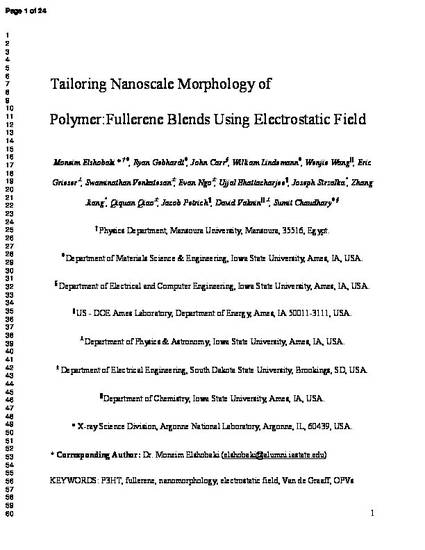
To tailor the nanomorphology in polymer/fullerene blends, we study the effect of electrostatic field (E-field) on the solidification of poly(3-hexylthiophene-2, 5-diyl) (P3HT):[6,6]-phenyl-C61-butyric acid methyl ester (PC60BM) bulk heterojunction (BHJ). In addition to control; wet P3HT:PC60BM thin films were exposed to E-field of Van de Graaff (VDG) generator at three different directions—horizontal (H), tilted (T), and vertical (V)—relative to the plane of the substrate. Surface and bulk characterizations of the field-treated BHJs affirmed that fullerene molecules can easily penetrate the spaghetti-like P3HT and move up and down following the E-field. Using E-field treatment, we achieved favorable morphologies with efficient charge separation, transport, and collection. We improve; (1) the hole mobility values up to 19.4 × 10–4 ± 1.6 × 10–4 cm2 V–1 s–1 and (2) the power conversion efficiency (PCE) of conventional and inverted OPVs up to 2.58 ± 0.02% and 4.1 ± 0.40%, respectively. This E-field approach can serve as a new morphology-tuning technique, which is generally applicable to other polymer–fullerene systems.
Available at: http://works.bepress.com/jacob_petrich/81/

This document is the unedited Author’s version of a Submitted Work that was subsequently accepted for publication as Elshobaki, Moneim, Ryan Gebhardt, John Carr, William Lindemann, Wenjie Wang, Eric Grieser, Swaminathan Venkatesan, Evan Ngo, Ujjal Bhattacharjee, Joseph Strzalka, Zhang Jiang, Qiquan Qiao, Jacob Petrich, David Vaknin, and Sumit Chaudhary. "Tailoring nanoscale morphology of polymer: Fullerene blends using electrostatic field." ACS Applied Materials & Interfaces 9, no. 3 (2016): 2678-2685, copyright © American Chemical Society after peer review. To access the final edited and published work see doi: 10.1021/acsami.6b10870. Posted with permission.